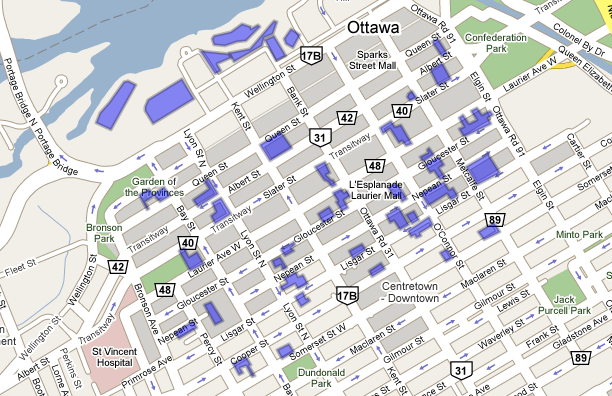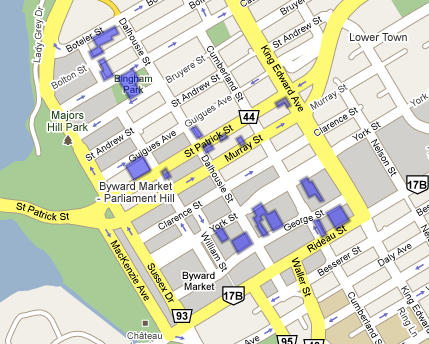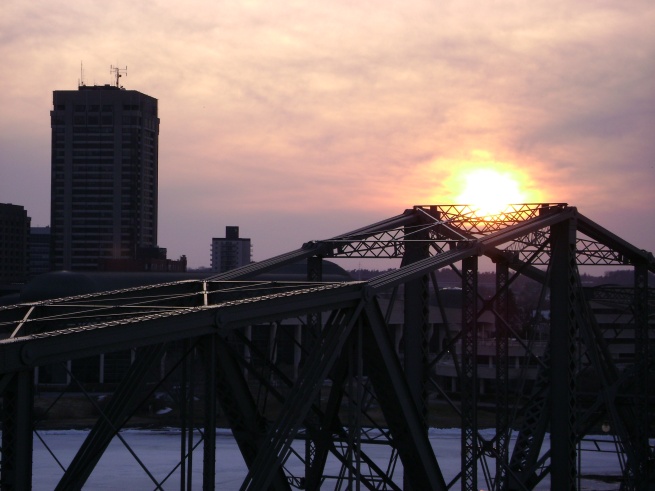Perhaps unsurprisingly, Ottawa City Council yesterday voted in favour of further exploring a deal to redevelop Lansdowne Park around a new Canadian Football League Franchise, beating out Senators Sports and Entertainment’s bid for a soccer stadium in Kanata. If you read this blog regularly, then I’m sure you know that I’m all in favour of major developments like this being built downtown, but the more I think about it the more I have to question whether or not the City made the right decision.
It’s not that I think a Kanata stadium would be better—far from it—but rather I’m concerned that a third option was not analyzed as much as it should have been: Bayview. The idea of a stadium at Bayview first came up a couple months ago, when the City released it’s survey of potential stadium sites, which wound up ranking the area, located between Tunney’s Pasture and Lebreton Flats, first overall.
And the more I think about it, the more I feel that a stadium at Bayview would be much better overall for the city. First of all, it’s got location. Sure, Lansdowne is right in the middle of the city, but it’s not easily accessible. Short of running light rail down Bank Street (a pipe dream at best), it’s not serviced by rapid transit, and it is only connected to the 417 by two narrow and easily congested roadways. Bayview, on the other hand, will be located right at the transfer station between our future east-west and north-south light rail lines, and can take in road traffic off the Ottawa River Parkway. And as a bonus, Bayview also offers the chance to construct a stadium with stunning views of downtown Ottawa and the Ottawa River—perhaps not the most important factor, but these things never hurt.
Secondly, I think that we’re slowly coming towards an unavoidable truth: Ottawa needs a new stadium, not to rebuild an old one. Frank Clair Stadium is, for all intents and purposes, falling apart at the seams. I was there a number of times in the fall to cover Gee-Gees games, and it was obvious that there was very little worth salvaging there. You can slap however many new coats of paint on it you want, but it doesn’t change the fact that it’s an old, creaky concrete monstrosity with few of the creature comforts people expect from modern stadiums. And in the Citizen article I linked to at the beginning of this post, you’ll note that even with the proposed upgrades, there’s only an estimated 28 years of life left in Frank Clair… is that worth $100 million?
Given all this, I think the choice is clear. Bayview is the best place for a stadium, and because we’ll probably end up needing a new one anyway, we might as well build it in the best possible location. It’s not like anyone will miss a dumping ground for snow removal, anyway.








Weighing in on atheist bus ads
Tags: news and comment, Ottawa politics, transit
“There probably is no god. Now stop worrying and enjoy your life.”
Twelve words that have caused a lot of controversy, and not just in Ottawa. They’re the text of a series of ads placed on buses in a number of cities around the world, including London (UK) and Toronto. In Ottawa, meanwhile, the ads were flatly rejected by OC Transpo, citing an advertising policy that states: “Religious advertising which promotes a specific ideology, ethic, point of view, policy or action, which in the opinion of the City might be deemed prejudicial to other religious groups or offensive to users of the transit system is not permitted. Religious advertising will be permitted if the information is designed to promote a specific meeting, gathering or event and the location, date and time of said event.”
That’s all well and good, and I can understand that policy perfectly, if it weren’t for this, from another article: “In 2007, OC Transpo approved ads for Bus Stop Bible Studies, a campaign on panels inside buses quoting scripture and asking life’s big questions. Roughly 2,400 ads have run in Calgary, Burlington and Toronto, but the sponsor has not yet raised enough money to place the ads on Ottawa buses.”
Regardless of the fact that these ads have not yet run, they were approved in principle well over a year ago. Based on the description, they seem to promote a clear religious ideology, but without being overly pushy or blatent, much like the proposed atheist ads. Of course, the subtext here is that qualifer on the first part of the policy, where the officials can deem something offensive. By extension, then, OC Transpo has basically just gone ahead and called atheism offensive.
Now, I’m an atheist, so I have a clear bias here. I’ve always felt fairly lucky to live when and where I do, because I’ve never really felt discriminated against for my beliefs, but this is a slap in the face. Based on the precedent of approving the Bus Stop Bible Studies campaign, there is absolutely no reason why the atheist campaign should be rejected. Really, it just makes the city look very close-minded and conservative, which is certainly not the image we should be projecting as Canada’s fourth largest urban area and national capital. In short, the decision is ridiculous, discriminatory, and borderline offensive.
The larger question, of course, is whether or not religious ads should be allowed at all in the public realm, to which I would say no. Religious debate is a tricky thing, and by wading into it—as seen in this case—officials risk being seen as taking sides and causing conflict. In private publications and the like is one thing, but with government-owned organizations like OC Transpo, there probably is a line that should be drawn.
All of that aside, though, I will be following this debate and how it turns out very closely. With any luck, a solution that is equitable to all will be found soon.